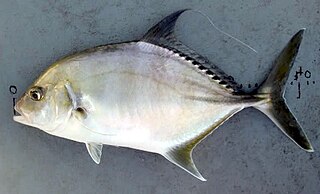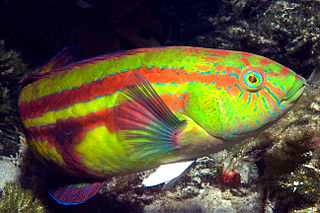
The quagga catshark is a species of catshark, belonging to the family Scyliorhinidae. A small, slim-bodied shark reaching 37 cm (15 in) in length, it has a distinctive color pattern of narrow, dark brown vertical bars, which resemble those of the quagga. Its head is short and flattened, with a pointed snout tip that is not upturned.

The Arabian carpetshark is a species of carpet shark in the family Hemiscylliidae, inhabiting coral reefs and other shallow coastal habitats from the Persian Gulf to India. Reaching 78 cm (31 in) long, this shark is characterized by a slender, plain brown body, and by two dorsal fins with straight trailing margins and the second smaller but longer-based than the first. The Arabian carpetshark feeds on bony fishes and invertebrates. Reproduction is oviparous with an annual cycle; females deposit egg capsules four at a time and the young hatch after 70–80 days. This small shark is often captured as bycatch but rarely used by humans. It has been assessed as Near Threatened by the International Union for Conservation of Nature (IUCN), as there is increasing fishing pressure and habitat degradation within its range. It does well in aquariums and has been bred in captivity.

Epinephelus albomarginatus, the white-edged grouper, white-edged rockcod or captain fine, is a species of marine ray-finned fish, a grouper from the subfamily Epinephelinae which is part of the family Serranidae, which also includes the anthias and sea basses. It is found in the southwestern Indian Ocean and it is associated with coral reefs. It is a target species for commercial and recreational fisheries.

The club-foot whiting, Sillaginopodys chondropus,, the only member of the genus Sillaginopodys, is a coastal marine fish of the smelt whiting family Sillaginidae that inhabits a wide range including west Africa, India and the northern Indonesian Archipelago. The species is unique in the morphology of the pelvic spine and fin, making identification of the species easier than most of its relatives. The species is of minor commercial importance, taken by seine net and marketed fresh throughout its range.

The trout barb, or Indian trout is a carp of the family Cyprinidae, which occurs in freshwaters around the Bay of Bengal.

The cleftbelly trevally, also known as the cleftbelly kingfish, Kuweh trevally or thin crevalle, is a species of tropical marine fish of the jack family, Carangidae. The species inhabits coastal waters throughout the Indo-West Pacific region from South Africa in the west to Japan in the east, often found near the water's surface. The cleftbelly trevally is the only member of the genus Atropus and is distinguished by a number of anatomical characteristics, with a deep median groove in the belly giving the species its common name. It is not a large fish, growing to a maximum recorded length of 26.5 cm. Cleftbelly trevally are predatory fish, taking a variety of small crustaceans and fish. The species is of minor importance to fisheries throughout its range.

The shadow trevally, also known as the shadow kingfish, twothread trevally or Aldabra trevally, is a species of inshore marine fish in the jack family Carangidae. The species is patchily distributed throughout the tropical and subtropical waters of the Indian and west Pacific Oceans, from South Africa in the west to Japan and Samoa in the east, reaching as far south as Indonesia and New Caledonia. It is most easily distinguished from similar species by as series of dark rectangular blotches under the second dorsal fin, giving a 'shadowed' appearance, from which its common name is derived. The shadow trevally is a reasonably large fish, growing to 85 cm in length and at least 2.6 kg in weight. It inhabits shallow coastal waters, including reefs, bays, and estuaries, where it takes small fish and benthic crustaceans as prey. Nothing is known of the species' ecology and reproductive biology. It is of little importance to fisheries, and is occasionally taken by bottom trawls and other artisanal fishing gear.

The coachwhip trevally, also known as the oblong trevally or oblique-banded trevally, is a species of inshore marine fish classified in the jack family Carangidae. The coachwhip trevally is distributed through the Indo-west Pacific region, ranging from South Africa in the west to Fiji and Japan in the east. It is a moderately large fish, growing to a known maximum length of 46 cm and can be distinguished from similar species by an array of detailed morphological features including dentition, fin ray counts and scale patterns. The coachwhip trevally inhabits coastal waters throughout its range, known to prefer estuarine waters in a number of localities. Nothing is known of its diet or reproductive biology, and is of little importance to fisheries, occasionally taken as bycatch in trawl and hook and line fisheries.

Osteobrama belangeri (Pengba/Belengee) is a species of ray-finned fish in the genus Osteobrama it was found in the Indian state of Manipur, but has been extirpated there and is found only in aquaculture, and in Myanmar. It is used as a food fish, from fish farms in Manipur and wild caught in Myanmar. The extirpation of this species from Manipur was caused by dam building, habitat degradation and the introduction of alien species which caused the populations to fragment.

Osteobrama cotio is a species of ray-finned fish in the genus Osteobrama. This species had three subspecies named O. cotio cotio, O. cotio cunma and O. cotio peninsularis but these are now considered separate species. This species is found in the drainage basins of the Ganges-Brahmaputra including Jiri River in Manipur, Barak River in Silchar, in Brahmaputra River, Uzan Bazaar in Assam, and in Bihar, Madhya Pradesh, Uttar Pradesh, and Punjab in India, and in Bangladesh. The presence of O. cotio in southern India and from the Indus basin of India and Pakistan needs to be confirmed. This species is threatened by extensive loss of habitat caused by pollution and deforestation.

Osteobrama feae is a species of ray-finned fish in the genus Osteobrama which is found in the Indian state of Manipur and in Myanmar, being common throughout its range. It grows to 15 cm in length and is of minor fisheries interest. This species has 65 lateral line scales and a very deep laterally compressed body which is bright silvery in colour becoming a more olive shade on the back. It has a rounded snout with a pair of mandibular barbels and a pair of maxillary barbels. The specific name honours the collector of the type, the Italian zoologist Leonardo Fea (1852-1903).

The Australian reticulate swellshark is a little-known species of catshark in the family Scyliorhinidae. It is found off the coast of northwestern Australia at depths of 290–420 m (950–1,380 ft). This shark has a stocky body and a short, wide head with a capacious mouth. It is characterized by a striking dorsal color pattern of dark brown lines that trace a series of hollow saddles and narrow rings, on a light background. Like other swellsharks, this species can inflate itself when threatened. Its reproduction is oviparous.
Gobioclinus gobio is a strictly marine ray finned fish, also called Gobioclinus gobio. Its common name is the palehead blenny, and is sometimes referred to as the goggle-eye blenny. It can be identified by its greenish top, red belly, and multicolored banding. L. gobio is a benthic organism with a wide range, taking up residence in a number of coastal environments from Florida to Brazil. This means the fish can live in equatorial, subtropical, and tropical climatic zones. It is native to coastal areas of the Caribbean. Its diet consists mainly of different molluscs and echinoderms.

The Indian Scad, also known as the Northern mackerel scad, round scad, Russell's mackerel scad, slender scad or the three lined grunter, is a species of ray-finned fish of the genus Decapterus which is part of the family Carangidae and which occurs in the Indian Ocean. It has colonised the eastern Mediterranean through the Suez Canal. It is an important species in coastal fisheries throughout its range.

Amblypharyngodon chulabhornae, the princess carplet, is a species of carplet in the family Cyprinidae from mainland south-east Asia.

Hypselobarbus mussullah is a species of freshwater ray-finned fish from the Indian endemic genus Hypselobarbus in the carp and minnow family Cyprinidae.
Osteobrama peninsularis is a species of freshwater ray-finned fish from the carp and minnow family, the Cyprinidae. It occurs in the Indian states of Andhra Pradesh, Karnataka, Maharashtra and Kerala. It has been recorded from the drainages of the Krishna River and the Godavari River as well as the Periyar River. Formerly this taxon was confused with Osteobrama cunma and this means that its distribution is uncertain, although it is described as common in Pune and the surrounding areas and in Karnataka. Like O. cunma it was formerly treated as a subspecies of Osteobrama cotio.
Trachurus delagoa, the African scad, is a species of jack mackerel from the family Carangidae which is found in the south western Indian Ocean.

Pictilabrus laticlavius, the patrician wrasse, the senator wrasse, the green parrotfish or the purplebanded wrasse is a species of marine ray-finned fish from the family Labridae, the wrasses. It is found in the eastern Indian Ocean and the south western Pacific Oceans off he temperate coasts of southern Australia.















